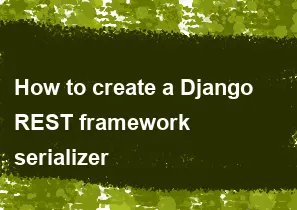How to create a Django REST framework serializer

Creating a Django REST framework serializer involves defining a class that inherits from serializers.Serializer and specifying the fields you want to include in the serialized output. Here's a step-by-step guide to creating a Django REST framework serializer:
Install Django REST framework: If you haven't installed Django REST framework yet, you can install it using pip:
bashpip install djangorestframeworkCreate a Django app: If you haven't already, create a Django app in your project:
bashpython manage.py startapp your_app_nameDefine your model: If you're working with a Django model, make sure you have a model defined. For example:
python# models.py in your app from django.db import models class YourModel(models.Model): name = models.CharField(max_length=255) description = models.TextField()Create a serializer: Create a new file, such as
serializers.py, in your app directory and define a serializer for your model:python# serializers.py in your app from rest_framework import serializers from .models import YourModel class YourModelSerializer(serializers.Serializer): class Meta: model = YourModel fields = '__all__' # Use '__all__' to include all fields, or specify specific fields as a listIf you're working with a
ModelSerializer(which is a shortcut for creating serializers for models), you can do:python# serializers.py in your app from rest_framework import serializers from .models import YourModel class YourModelSerializer(serializers.ModelSerializer): class Meta: model = YourModel fields = '__all__'Use the serializer in views or viewsets: In your views or viewsets, import the serializer and use it to serialize data:
python# views.py or viewsets.py in your app from rest_framework.response import Response from rest_framework.views import APIView from .models import YourModel from .serializers import YourModelSerializer class YourModelView(APIView): def get(self, request): queryset = YourModel.objects.all() serializer = YourModelSerializer(queryset, many=True) return Response(serializer.data)Alternatively, if you're using viewsets:
python# views.py or viewsets.py in your app from rest_framework import viewsets from .models import YourModel from .serializers import YourModelSerializer class YourModelViewSet(viewsets.ModelViewSet): queryset = YourModel.objects.all() serializer_class = YourModelSerializerRemember to wire up your views or viewsets to URLs in your
urls.pyfile.
That's it! You've created a Django REST framework serializer for your model. Adjust the fields and configurations based on your specific requirements.
-
Popular Post
- How to optimize for Google's About This Result feature for local businesses
- How to implement multi-language support in an Express.js application
- How to handle and optimize for changes in mobile search behavior
- How to handle CORS in a Node.js application
- How to use Vue.js with a UI framework (e.g., Vuetify, Element UI)
- How to configure Laravel Telescope for monitoring and profiling API requests
- How to create a command-line tool using the Commander.js library in Node.js
- How to implement code splitting in a React.js application
- How to use the AWS SDK for Node.js to interact with various AWS services
- How to use the Node.js Stream API for efficient data processing
- How to implement a cookie parser middleware in Node.js
- How to implement WebSockets for real-time communication in React
-
Latest Post
- How to implement a dynamic form with dynamic field styling based on user input in Next.js
- How to create a custom hook for handling user interactions with the browser's device motion in Next.js
- How to create a custom hook for handling user interactions with the browser's battery status in Next.js
- How to implement a dynamic form with dynamic field visibility based on user input in Next.js
- How to implement a dynamic form with real-time collaboration features in Next.js
- How to create a custom hook for handling user interactions with the browser's media devices in Next.js
- How to use the useSWRInfinite hook for paginating data with a custom loading indicator in Next.js
- How to create a custom hook for handling user interactions with the browser's network status in Next.js
- How to create a custom hook for handling user interactions with the browser's location in Next.js
- How to implement a dynamic form with multi-language support in Next.js
- How to create a custom hook for handling user interactions with the browser's ambient light sensor in Next.js
- How to use the useHover hook for creating interactive image zoom effects in Next.js